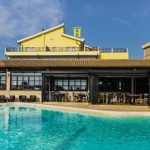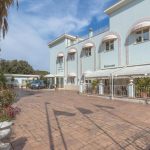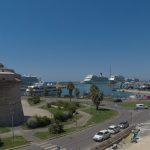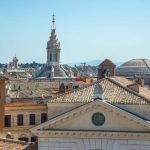Language : Italian
Currency : Euro
Civitavecchia Cruise Port
Cruise lines use the port of Civitavecchia for visits to Rome. Civitavecchia is a major port for embarkation and disembarkation particularily for cruise itineraries visiting the Eastern Mediterranean. The port is about 70 km’s from the centre of Rome and the journey takes about 1 hour 15 minutes by road. The closest airport to the cruise port is Fiumicino about 70 km’s taking around 1 hour by road – see here if you are looking for a transfer between either the airport, Rome or Civitavecchia.
The port area is served by a good train service both between Civitavecchia and Fiumicino and the port and Rome. From the airport there is one change required and the journey will take about 1 hour 20 minutes to 1 hour 45 minutes. The train between Civitavecchia and Rome takes between 45 minutes and 1 hour 30 minutes depending which train you take. The Leonardo Express operates from Fiumicino to Rome Termini station in central Rome and the journey will take a little over 30 minutes.
The train station in Civitavecchia is around 1.5 kms from the port entrance – a pleasant 20 minute walk along the beachfront. With baggage however it may be beneficial to take the shuttle bus service which operates between the train station and the port gates. Tickets can be purchased on board – in 2025 the cost was 6 euro per person each way.
However you plan to arrive at the port gates you then have the option of walking to the cruise terminal – it is about 500 mts and will take 10 – 15 minutes, or take the free port authority shuttle bus.
The cruise terminal itself is quite new and modern and operates a large check in area and baggage hall.
Civitavecchia
Civitavecchia itself is a pleasant enough beach town – although the beach is pebbled !. Civitavecchia, the port of Rome, is the point of arrival and departure of hundreds of ships, cruises, ferries travelling all around the Mediterranean. From here it is possible to reach Sardinia, Corsica, Sicily, Spain, France, some other small islands, and even north Africa.
The main street between the train station and the harbor has a lot of restaurants, pizzerias, bars, etc. for some good food that can be found relatively cheap. Many people hang out here at night and sit around and have a bite to eat and some vino. Great place to people watch in this small town.
- Pizzeria al Ghetto. Only open at night and worth the wait! Locals love this place. Outside tables fill up fast so get there early. Only two kinds of pizza, margarita or anchovy. Get it with a cold beer and enjoy the food and atmosphere.
- Ristorante Stuzzichino. Open at night and at lunch, it’s situated in the historical city centre of Civitavecchia. You can taste the local seafood cuisine, in a cozy atmosphere. The restaurant is not very big, so it’s recommended to make a reservation.
The main sights of interest largely relate to the Roman Empire and sit outside of the town.
- National Archeological Museum Preserves exciting finds from the Roman port and Taurine spas (just outside Civitavecchia), and the 845 inscription that celebrates the city’s reconstruction after being destroyed by the Saracen.
- Michelangelo stronghold The impressive fortress built in the sixteenth century with the assistance of the great Michelangelo Buonarroti.
- Terme Taurine The thermal complex built by the Roman Emperor Trajan is still well preserved. The rest of the Terme Taurine are north, around 1 hour walking from the harbour. Civitavecchia Pro Loco provides free buses from the harbour.
- Ficoncella Thermal Bath North of the city close to the Terme Taurine there is the Ficoncella bath frequented by Romans and still popular with the Civitavecchiesi. The modern name stems from the fig plants among the various pools.
- La Cattedrale The cathedral of San Francesco d’Assisi was built by the Franciscans over an existing small church built from 1610. The current edifice, with Baroque-Neoclassical lines, was erected in the eighteenth century. It’s situated between the historical centre of the city and Viale Garibaldi.
Rome
For most cruise guests though Rome is the main attraction.
Rome (Italian and Latin: Roma), the ‘Eternal City’, is the capital and largest city of Italy and of the Lazio region. It’s the famed city of the Roman Empire, the Seven Hills, La Dolce Vita, the Vatican City and Three Coins in the Fountain. Rome, as a millennia-long centre of power, culture and religion, was the centre of one of the greatest civilisations ever, and has exerted a huge influence over the world in its circa 2500 years of existence.

The historic centre of the city is a UNESCO World Heritage Site. With wonderful palaces, thousand-year-old churches and basilicas, grand romantic ruins, opulent monuments, ornate statues and graceful fountains, Rome has an immensely rich historical heritage and cosmopolitan atmosphere, making it one of Europe’s and the world’s most visited, famous, influential and beautiful capitals. Today, Rome has a growing nightlife scene and is also seen as a shopping heaven, being regarded as one of the fashion capitals of the world; some of Italy’s oldest jewellery and clothing establishments were founded in the city. With so many sights and things to do, Rome can truly be classified a “global city”.
Situated on the River Tiber, between the Apennine Mountains and the Tyrrhenian Sea, the “Eternal City” was once the administrative centre of the mighty Roman Empire, governing a vast region that stretched all the way from Britain to Mesopotamia. Today it remains the seat of the Italian government and home to numerous ministerial offices. Rome has 2.7 million inhabitants
Central Rome
Rome can be divided into several districts. The so-called historical centre (centro storico) is quite small, being only around 4% of the city’s area. This mainly consists of the area inside the Aurelian walls, and is protected by UNESCO. Districts are explained below:
Modern Centre
Where many of the hotels are, as well as shopping and dining galore along the Via Veneto; home to the Quirinale, Trevi fountain, Barberini, Castro Pretorio, and Repubblica areas.
The centre of the Roman medieval and Renaissance periods, with beautiful plazas, cathedrals, the Pantheon, and plenty of laid-back dining; includes the Navona, Campo de’ Fiori, and the Jewish Ghetto neighbourhoods.
The Papal City State and its endless treasure troves of sights, relics, and museums, as well as the surrounding Italian neighbourhood.
The heart of ancient Rome, the Colosseum, the Roman Forum, the Forum of Augustus, the Forum and Markets of Trajan, the Capitoline and its museums.
Situated in the north part of Rome, home to the Villa Borghese, the Spanish Steps, and the elegant neighbourhoods of Parioli and Salario.
Once you’re in the centre, you are best off on foot. Crossing a street in Rome can be a bit challenging. There are crosswalks, but they are rarely located at signalled intersections. Traffic can be intimidating, but if you are at a crosswalk just start walking and cars will let you cross the street. While crossing watch out for the thousands of mopeds. As in many European cities, even if the cars and trucks are stationary due to a jam or for another legal reason, mopeds and bikes will be trying to squeeze through the gaps and may be ignoring the reason why everyone else has stopped. This means that even if the traffic seems stationary you need to pause and look around into the gaps. In high season, in the most touristed parts of the city there will almost certainly be other people crossing the street somewhere nearby – go with the crowd and the cars will stop. Old Rome has some cobble-stoned streets that may not be stroller-friendly. Wear comfortable shoes for walking.
ATAC operates the public transport network. There are two ways of buying public transport tickets in Rome: Tap&Go with a contactless credit/debit card (incl. on a mobile phone) or paper tickets. Paper tickets offer the most variety but the other options are more convenient for visitors.
You can board any bus, Metro or tram by tapping a contactless credit/debit card, including through Apple Pay/Google Pay. You are charged per journey. A journey is valid for 100 minutes; transfers to other bus, Metro or tram lines are permitted.
Paper tickets must be bought (from a ‘Tabacchi’ – look for the big ‘T’ sign, or from a kiosk selling newspapers; cash only) before you board the bus, Metro, or tram. Metro stations have automated ticket kiosks, and major Metro stations have clerked ticket windows. Some of the trams have single ticket machines as well. Tickets for regular ATAC buses, the Metro, and trams are the same fares and are compatible with each other. When you board the bus, Metro or tram you have to validate the ticket in the little yellow machine. The last four types of ticket on the list above must be validated the first time you use them only. On the whole, the integrated passes are not economical. Unless you take many rides spread all over the day, the single ticket ride option is preferable.
Ancient Rome
The main area for exploring the ruins of ancient Rome is in Rome/Colosseo either side of Via dei Fori Imperiali, which connects the Colosseum and Piazza Venezia. Constructed between 1931 and 1933, at the time of Mussolini, this road destroyed a large area of Renaissance and medieval buildings constructed on top of ruins of the ancient forums and ended forever plans for an archaeological park stretching all the way to the Appian Way. Heading towards the Colosseum from Piazza Venezia, you see the Roman Forum on your right and Trajan’s Forum and Market on the left. To the right of the Colosseum is the Arch of Constantine and the beginning of the Palatine Hill, which will eventually lead you to ruins of the Flavian Palace and a view of the Circus Maximus. To the left, after the Colosseum is a wide, tree-lined path that climbs through the Colle Oppio park. Underneath this park is the Golden House of Nero (Domus Aurea), an enormous and spectacular underground complex restored and then closed again due to damage caused by heavy rain. Further to the left on the Esquiline Hill are ruins of Trajan’s baths.
In Old Rome you must see the Pantheon, which is amazingly well preserved considering it dates back to 125 AD. There is a hole constructed in the ceiling so it is an interesting experience to be there when it is raining. If you are heading to the Pantheon from Piazza Venezia you first reach Largo di Torre Argentina on your left. Until 1926 this was covered in narrow streets and small houses, which were razed to the ground when ruins of Roman temples were discovered. Moving along Corso Vittorio Emmanuelle and crossing the Tiber river into the Vatican area you see the imposing Castel Sant’ Angelo, built as a Mausoleum for the Emperor Hadrian. This is connected by a covered fortified corridor to the Vatican and served as a refuge for Popes in times of trouble.
South of the Colosseum are the Baths of Caracalla (Aventino-Testaccio). You can then head South-East on the old Appian Way, passing through a stretch of very well-preserved city wall. For the adventurous, continuing along the Appian Way (Rome/South) will bring you to a whole host of Roman ruins, including the Circus of Maxentius, the tomb of Cecilia Metella, the Villa dei Quintili and, nearby, several long stretches of Roman aqueduct.
Returning to the Modern Centre, the Baths of Diocletian are opposite the entrance to the main railway station, Termini. The National Museum of Rome stands in the South-West corner of the Baths complex and has an enormous collection of Roman sculptures and other artefacts. But this is just one of numerous museums devoted to ancient Rome, including those of the Capitoline Hill. It is really amazing how much there is.
Catholic Rome

There are more than 900 churches in Rome; probably one third would be well worth a visit!
In Catholic tradition, St. Peter is said to have founded the church in Rome together with St. Paul. The first churches of Rome originated in places where early Christians met, usually in the homes of private citizens. By the IVth Century, however, there were already four major churches, or basilicas. Rome had 28 cardinals who took it in turns to give mass once a week in one of the basilicas. In one form or another the four basilicas are with us today and constitute the major churches of Rome. They are St Peter’s, St Paul’s Outside the Walls, Santa Maria Maggiore and San Giovanni.
Take a look inside a few churches. You’ll find the richness and range of decor astonishing, from fine classical art to tacky electric candles.
Some churches in Rome deny admission to people who are dressed inappropriately. You will find “fashion police” at the most visited churches. (“Knees and shoulders” are the main problem – especially female ones.) Bare shoulders, short skirts, and shorts are officially not allowed, but long shorts and skirts reaching just above the knee should generally be no problem. However, it’s always safer to wear longer pants or skirts that go below the knee; St. Peter’s in particular is known for rejecting tourists for uncovered knees, shoulders, midriffs, etc. (You also generally won’t be told until right before you enter the church, so you will have made the trek to the Vatican and stood in a long security line for nothing.) The stricter churches usually have vendors just outside selling inexpensive scarves and sometimes plastic pants. But relatively few churches enforce dress codes and you can wander into most wearing shorts, sleeveless shirts, or pretty much anything without problems. It is, however, good to keep one’s dress tasteful, as these are still churches and houses of prayer for many people.
If you are in Rome for the Arts there are several world-class museums in the city. The natural starting point is a visit to the area of Villa Borghese in Rome/North Center, where there is a cluster of art museums in and around the Borghese Gardens. Galleria Borghese houses a previously private art collection of the Borghese family, Museo Nazionale di Villa Giulia is home of the world’s largest Etruscan art collection, and Galleria Nazionale d’Arte Moderna houses many Italian masterpieces as well as a few pieces by artists such as Cézanne, Degas, Monet and Van Gogh.
The Capitoline Museums in the Colosseo district opens their doors to the city’s most important collection of antique Roman and Greek art and sculptures. Visit the Galleria d’Arte Antica, housed in the Barberini palace in the Modern centre, for Italian Renaissance and Baroque art.
A visit to Rome is not complete without a trip to the Vatican Museum. You need to go to the museum if you want to see the Sistine Chapel, but there is an enormous collection. You cannot miss part of this, such as tapestries, maps and the rooms painted by Rafael, as they are en route to the Sistine Chapel, but there is much, much more to explore, including a stunning Egyptian collection, and the Pinacoteca, which includes a Portrait of St. Jerome by Leonardo da Vinci and paintings by Giotto, Perugino, Raphael, Veronese, Caravaggio, and others.
Rome’s National Museum at the Baths of Diocletian in the Modern Centre has a vast archaeological collection as does the national museum at Palazzo Altemps, close to Piazza Navona. Further afield, the Museo di Civilta Romana (Museum of Rome’s Civilization), in EUR is most famous for an enormous model of Imperial Rome, but also has an extensive display of plaster casts, models and reconstructions of statues and Roman stonework.
If you have plenty of time there is absolutely no shortage of other museums covering a wide variety of interests. Examples include the Museum of the Walls (see Rome/South), the Musical Instrument Museum and a museum devoted to the liberation of Rome from German occupation in the Second World War (Rome/Esquilino-San Giovanni).
The narrow streets frequently broaden out into small or large squares (piazzas), which usually have one or more churches and a fountain or two. Apart from Piazza Navona and Piazza della Rotonda (in front of the Pantheon), take in the nearby Piazza della Minerva, with its unique elephant statue by Bernini and Piazza Colonna with the column of Marcus Aurelius and Palazzo Chigi, meeting place of the Italian Government. On the other side of Corso Vittorio Emanuele are Piazza Farnese with the Palazzo of the same name (now the French Embassy) and two interesting fountains and the flower sellers at Campo dei Fiori, scene of Rome’s executions in the old days. All of these squares are a short distance from each other in Old Rome. The enormous Piazza del Popolo in the North Centre, which provided an imposing entrance to the city when it represented the northern boundary of Rome, is well worth a visit. A short walk back towards the centre brings you to Piazza di Spagna at the foot of the Spanish Steps. Yet another fascinating fountain here. The area was much used as backdrop for the 1953 film Roman Holiday with Audrey Hepburn and Gregory Peck.

On the other side of the river is, of course, the magnificent square of St Peter’s at the Vatican. Further south, in Trastevere is Piazza Santa Maria in Trastevere, a great place to watch the world go by, either from one of the restaurants or bars that line two sides of the square or, if that is too expensive, from the steps of the central fountain. The square attracts many street entertainers.
Moving back to the Modern Centre you have to see the Trevi Fountain, surely a part of everyone’s Roman holiday. Visitors are always amazed that such a big and famous fountain is tucked away in a small piazza in the middle of side streets. Take extra-special care of your possessions here. Further up the Via del Tritone you will come to Piazza Barberini, now full of traffic but the lovely Bernini fountain is not to be missed.
Rome is generally a safe place, even for women traveling alone. However, there have been rape cases around the Roma Termini train station, so be careful especially at night time. There is very little violent crime, but plenty of scams and pickpocketing that target tourists. As in any other big city, it is better if you don’t look like a tourist: don’t exhibit your camera to all and sundry, and keep your money in a safe place. Consciousness and vigilance are your best insurances for avoiding becoming a victim of a crime in Rome. Remember, if you are pickpocketed or victim of another scam, don’t be afraid to shout, “Aiuto, al ladro!” (Help, Thief!) Romans will not be nice to the thief.
Members of the Italian public are likely to be sympathetic if you are a crime victim. Police are also generally friendly if not always helpful. Carabinieri (black uniform, red striped trousers) are military police, and Polizia (blue and grey uniform) are civilians, but they both do essentially the same thing and are equally good, or bad. If you are robbed, try to find a police station and report it. This is essential to establishing a secure insurance claim and to replace documents: the chances of it resulting in the return of your possessions are, however, fairly remote.
In an emergency, call 112 (Carabinieri), 113 (Police), 118 (medical first aid) or 115 (firemen). Carry the address of your embassy or consulate.
Tours & Excursions
If Civitavecchia Rome is a port of call on your cruise and you are looking for the best choice of excursions then this is the perfect link for you.
If Civitavecchia Rome is your port of embarkation or disembarkation and you are planning a stay in Rome here are the best choice of excursions for you
3 Days in Rome
Day 1 – The perfect way to orientate your way around the eternal city – take the big bus hop on hop offf bus tour – buy your tickets in advance here. Eight stops at landmarks such as the Colosseum, Pantheon, Vatican City, and the Trevi Fountain
Day 2 – Explore Vatican City – a great tip is to purchase your entry tickets in advance to skip the lines – purchase yours here. Enter through a dedicated no-wait entrance and spend more time enjoying masterpieces like Michelangelo’s Sistine Chapel ceiling and the stunning Raphael’s Rooms
Day 3 – Take a guided tour of The Colosseum, Roman Forum and Pallatine Hill. Book your tour here
Where to stay in Civitavecchia
If you are embarking or disembarking your cruise in Civitavecchia and are just planning a one night pre or post cruise stay in the town here are our preferred hotels
Where to stay in Rome
If you are planning on a pre or post cruise stay in Rome here are our preferred hotels
Cruises from / to Rome Civitavecchia
We have found 232 cruises that embark in Rome Civitivecchia in 2026 – there will be many others that either disembark in Civitavecchia or visit as a port of call. With so many to choose from there really is a cruise from Civitavecchia for everyone. We have highlighted juts a few of our favourties, based on cruise line, ship, itinerary and price.








